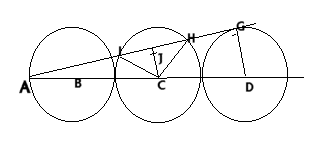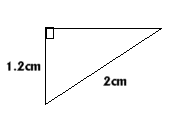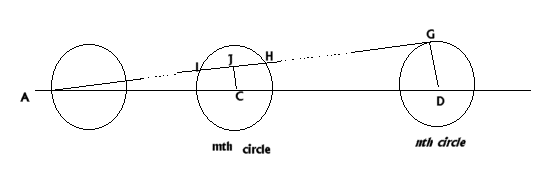Copyright © University of Cambridge. All rights reserved.
'Chord' printed from https://nrich.maths.org/
Show menu
 |
Congratulations to four students from
Madras College, Gordon and Alan from S6, Sue Liu from S4 and David
from S3. They all sent excellent solutions to this problem
including complete proofs of the general case. Answers also arrived
from St Peter's College in Adelaide,
Australia.
This is David's proof of the first part: Lines $CH$ and $CI$
can be drawn in. Both have length $R$ or 2 cm.
|
$ICH$ is an isosceles triangle which can be split into two congruent right angled triangles by drawing line $CJ$, where $J$ is the midpoint of chord $IH$.
Triangle $AJC$ is similar to triangle $AGD$, with a ratio of 6 cm to 10 cm or 3:5.
Line $GD = R= $2 cm,
Line $CJ =$ 3/5 $GD= $1.2 cm.
 |
Both right angled triangles $CJH$ and $CJI$ have lengths as
below and the length $JH$ can be worked out using Pythagoras'
theorem.
$JH^2 = 2^2 - 1.2^2 = 4 - 1.44 = 2.56 = 1.6^2$ So $JH = $1.6 cm and the chord $JH = $2(1.6)= 3.2 cm. |
This is Gordon's proof of the general case of n circles where $AG$ cuts the m th circle at $I$ and $H$.

$\angle ACJ$ is similar to $\angle ADG$
$\Rightarrow AD = 2 \times2(n - 1) + 2 = 4n - 2$ units
$\Rightarrow AC = 4m - 2$ units.
$\eqalign{ \frac{JC}{AC} &= \frac{DG}{AD} \\ \frac{JC}{4m
- 2} &= \frac{2}{4n - 2} \\ JC &= \frac{4m - 2}{2n -
1}}$
$\angle IHC$ is isosceles and $\angle CJI = \angle CJH =
90^{\circ}$.
Hence, by Pythagoras' theorem, $$IH = 2JH = 2\sqrt{2^2 -
\left(\frac{4m - 2}{2n - 1}\right)^2}$$ Simplifying this expression
gives $$IH = \frac{8}{2n - 1}\sqrt{n(n - 1) - m(m - 1)}$$ Checking
this where $n=3$ and $m=2$ $$IH = \frac{8}{5}\sqrt{6 - 2} =
\frac{16}{5} = 3.2$$